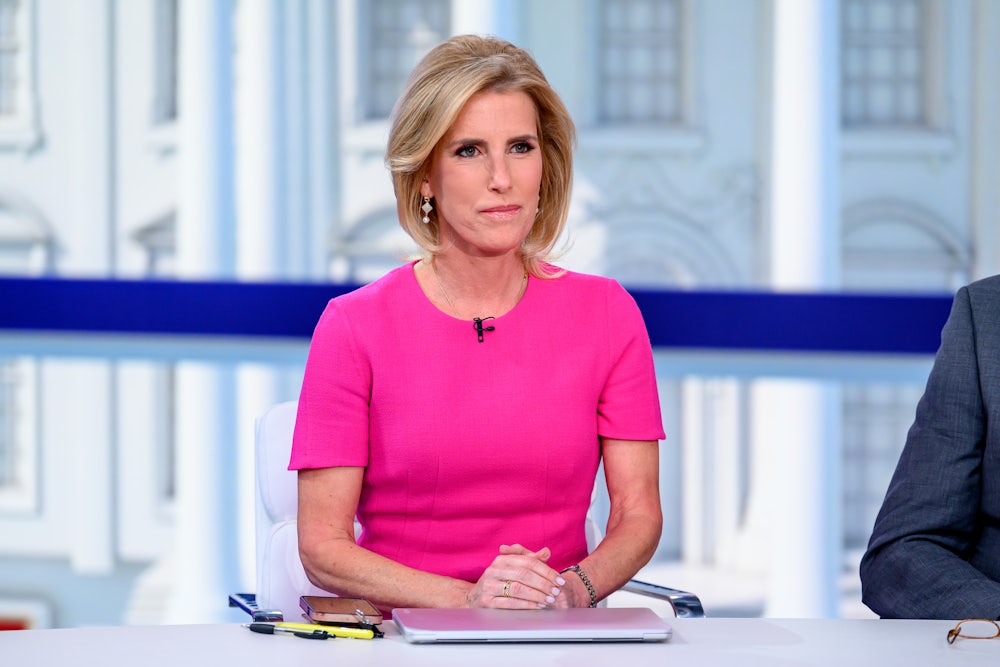MAGA influencers are in a rage over President Trump’s appearance on Fox News, in which he told host Laura Ingraham that the country needs skilled foreign workers. The surprisingly antagonistic dustup came after Ingraham challenged Trump’s support for visas for skilled workers, declaring that they “flood the country” with “hundreds of thousands of foreign workers.”
“I agree,” Trump said, before delivering the coup de grâce: “But you also do need to bring in talent.” When Ingraham claimed we have “talented people here,” Trump replied: “No, you don’t,” which appeared to mean that—sit down for this one—foreign workers actually can play a complementary and productive role in the U.S. economy. Ingraham was visibly irked when Trump argued that trained U.S. workers are not always available as needed, creating a need for foreign workers. After all, this is true MAGA heresy.
All this is being widely mocked as a gaffe: Doesn’t suggesting we have “no” talented people here undercut “America First”? But we should also see it as something else: an expression of Trump’s growing political weakness on the broader immigration issue. It also hints at a deeper schism in MAGA that Democrats should get serious about exploiting.
It’s often overlooked, but Trump sometimes has canny outbreaks of performative moderation at critical moments. Notably, this is the second time Trump has contradicted Stephen Miller on immigration: In June, Trump shocked MAGA by admitting that his mass deportations are depriving farmers of good, reliable workers. In both these cases, Trump broke—superficially and temporarily, at least—with the MAGA commitment to removing all undocumented and provisionally present immigrants as a demographic imperative that overrides all else.
All this should inform the debate unfolding among Democrats about how to position the party on immigration. Trump is unpopular on this issue. He’s very vulnerable on his mass removals, in particular. And as Trump’s argument with Ingraham suggests, all this gives Democrats an opening to divide MAGA further as they find their way forward.
Here’s another data point along these lines: Abigail Spanberger’s blowout victory in the Virginia gubernatorial contest. This has been missing from all the postelection analysis, but it turns out Spanberger took positions that strongly challenged Trump on immigration in ways that some Democrats have been reluctant to do.
For instance, Spanberger flatly vowed during the campaign to rescind a high-profile measure that GOP Governor Glenn Youngkin signed on immigration. Youngkin’s 2025 executive order directs localities to work with Trump’s federal immigration enforcement agencies. Spanberger sharply criticized the measure, saying it’s absurd to “take local police officers” and have them “tear families apart.”
Spanberger also opposed the conflating of violent criminals with nonviolent undocumented immigrants—which is central to Trump’s agenda—by claiming it discourages local communities from cooperating with law enforcement.
Now, it’s true that Spanberger has declared opposition to “sanctuary cities,” which shield the undocumented. But in practice, by supporting the repeal of Youngkin’s law enforcement directive—and criticizing arrests of noncriminal undocumented immigrants as undermining public safety—Spanberger positioned herself directly in opposition to Trump’s mass deportation regime. That’s exactly why Republicans attacked Spanberger, slamming her for supposedly coddling criminal undocumented migrants.
That’s not all. As a member of Congress, Spanberger voted against the Laken Riley Act, which mandates the federal detention of undocumented immigrants accused of even minor crimes, in flagrant violation of due process. She defended this vote during the campaign.
Despite these positions, Spanberger won by 15 points, a huge gain over four years earlier, and erased the GOP’s advantage with non-college voters. Indeed, as E.J. Dionne notes, Spanberger dramatically overperformed in lots of rural Virginia counties too. Notably, many of those southwest counties are in Appalachian Trump country. Spanberger called for reforms that would invest in a secure border and tighten asylum eligibility while creating broad new pathways for legal immigration into the country—yet did remarkably well in those places.
In a striking development, Republicans didn’t run ads attacking Spanberger’s positions on immigration, a national Democrat familiar with the campaign tells me. In one sense the Spanberger race isn’t the perfect test, because Republicans didn’t push the issue. But critically, this shows Spanberger’s opposition to Trump’s mass deportations was not in any sense a liability, and may have been an asset. Spanberger leveraged her law enforcement and CIA background to talk about the issue in a nuanced way. Republicans couldn’t exploit this even in Trumpy areas.
All of which undermines what some Democrats and pundits believe about this moment. Recall that when Arizona Senator Ruben Gallego preened around advertising his vote for the Laken Riley Act, he was widely feted as having the magic key to getting it right on immigration with working people and even with working-class Latinos.
Shocker: Spanberger voted against that bill—and opposed the Trump-Youngkin immigration enforcement agenda—and did remarkably well with the working class. Running in Arizona is not the same as running in Virginia, of course, but the point is, none of these positions prevented Spanberger from making big gains among working-class voters and even deep in Trump country. Hispanics snapped back to her in large numbers.
As G. Elliott Morris shows, the idea that Trumpism pulled off a grand realignment among the nonwhite working class is now in ruins. A big part of that realignment, you will recall, was supposedly driven by Trump’s dominance on immigration and Democrats’ clueless refusal to adapt to it. That idea is now in pretty rough shape too.
Here’s the deeper point: Lots of people overread the immigration-related significance of Trump’s 2024 victory. They looked at voter dissatisfaction with the state of the border under President Joe Biden and discerned an almost seismic cultural reaction to immigration levels inside the country. The former was very real. The latter has turned out to be a mirage.
Polls that ask nuanced questions about who should be deported find broad opposition to the removal of longtime residents with no criminal records. Very large majorities have reaffirmed support for immigration as a positive good for the country. The “nativist backlash” is mostly hype: There’s been no serious cultural shift toward wanting far fewer immigrants in the country, and if anything the culture has broadly recoiled against this, now that Trump is actually attempting it.
Which brings us back to Trump’s skirmish with Laura Ingraham.
Ingraham: Does that mean the h-1b visa thing will not be a big priority for your administration?
— Acyn (@Acyn) November 12, 2025
Trump: You have to bring in talent
Ingraham: We have plenty of talent
Trump: No, you don’t
Ingraham: We don’t have talented people here? pic.twitter.com/8HopYhqMP1
This exchange shows that a large swath of MAGA is adamantly committed to mass removals as a way to reengineer the country’s demographics. Trump is committed to this as well, but he faces blowback when he departs from it even marginally, and there are clearly elements in the MAGA coalition who are not committed to it.
The farmers who are losing their workforces, the small-town Trump voters angry about removals of local “moms,” the business-minded Republicans who understand that immigrant workers are complementary to the U.S. economy—Democrats can appeal to those people, and drive a wedge into MAGA. Let’s not allow this to get lost in the postelection commentary: Spanberger showed that Democrats can speak to voters like grown-ups about Trump’s mass removals and masked ICE stormtroopers—and not only win, but win big.






